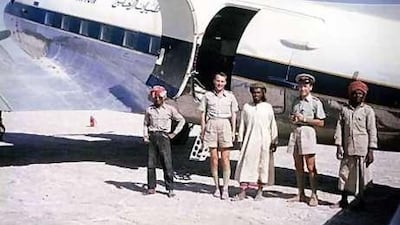DUBAI // When the call came in, Captain James Stokes reported immediately for duty. He had been instructed by his superior officer to fly an Egyptian official from Abu Dhabi to the desert camps of the emirate, on a mission in search of Sheikh Zayed.
It was the late 1960s, and Captain Stokes was a pilot with Gulf Aviation, which had been operating since 1950. After taking the call, he duly ferried the official to a succession of desert airstrips in his small De Havilland Dove propeller-driven aircraft. "That's the way it was then," says Capt Stokes, now 85. "There were no roads as such in the Trucial States. We had to find ways to get to destinations by air."
Although they failed to find Sheikh Zayed, there was, it transpired, another future president on board. For the Egyptian official Captain Stokes's superiors referred to was Anwar Sadat, who would go on to lead his country for 11 years, and receive a Nobel Peace Prize following the landmark Camp David peace accords with Israel. In keeping with the protocol of the era, Captain Stokes remains tight-lipped on his encounter. "[Sadat] ... was a polite and determined fellow," he says, recalling how the two flew in and out of desert airstrips before abandoning the mission to find Sheikh Zayed.
Captain Stokes, a former pilot with the British navy, flew with Gulf Aviation from 1961 to 1984. He now lives in retirement on a remote Cornish clifftop overlooking Mounts Bay, near the naval air station where he was based in the 1950s. Many of the stories and photos from his travels in the Gulf have been preserved by his son, Michael Stokes, 50. Michael has collected them in a Facebook page set up to commemorate the airline's 60th anniversary.
He said: "I wanted to commemorate the former employees and their families who worked with the first Gulf airline, which in turn helped in the development of the Gulf itself," said Michael, who grew up in Bahrain and moved to Dubai with his own family to work in banking. "The airline helped bring workers and vital components to the oil exploration firms who were in many of the remote sites of the Empty Quarter and the western regions of Abu Dhabi," Michael said.
One of his father's first assignments on joining the airline in 1961 was to fly to Dubai on the orders of the ruler of Bahrain, Sheikh Isa bin Salman al Khalifa, to collect survivors of the steamship Dara, which caught fire after a series of explosions, killing more than 200 people. "My father told me how the seats were taken out of a Gulf Aviation DC3 plane so they could carry as many injured as they could back to Bahrain for treatment," said Michael. "Dubai had no facilities in those days to cope with the number of burns victims. There were so many on board that many of the passengers had to stand."
Captain Stokes landed dozens of times in the UAE's first airport in Sharjah. It was a vital stopover on the old Imperial Airways route from Britain to India and Australia, as planes headed down from Iraq. With the opening of Dubai and Abu Dhabi airports in the early 1960s, Captain Stokes would often take his son along. "There wasn't much there in Abu Dhabi airport," says Michael. "Just a small single-storey building and landing strip where tribesmen would show up to see who and what the plane brought."
He remembers how he and a friend, aged around eight, would shoo away goats that had wandered on to the airstrip. The standard of navigational technology then meant planes often landed at the wrong airport entirely, often dodging pot-shots from Omani rebels in the mountains. It was a time of frontier adventure, and a period Captain Stokes remembers as the best years of his life. "We were the first aerial highway between oil well heads and ports, between desert plains and mountains," Captain Stokes recalls. "We would act as air ambulances from accident sites to hospitals, or royal flights carrying local rulers to emirs and sultans. We reached where no other could."
Captain Stokes was not the only one to leave a mark on Gulf Aviation. His wife, Joy, designed the airline's first female crew outfits in 1967. The knee-length skirt, with its stylish jacket and cap, was launched with the turboprop Fokker F-27, ushering in the age of passenger comfort and cabin service. In 1973, the airline was renamed Gulf Air, and a beige trouser suit was introduced, again designed by Mrs Stokes, with her iconic headscarf and hat ensemble. "My mother is proud to note the crew still wear her veiled hat design," says her son, Michael Stokes. @Email:rghazal@thenational.ae

